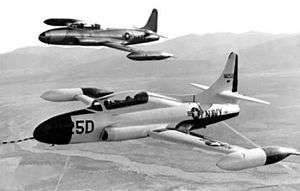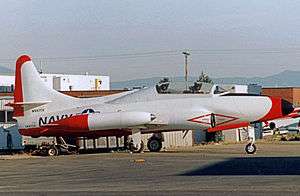Lockheed T2V SeaStar
| T2V-1 / T-1 SeaStar | |
|---|---|
 | |
| Lockheed T-1A Seastar in 1965 | |
| Role | Naval training aircraft |
| Manufacturer | Lockheed |
| First flight | 15 December 1953 |
| Introduction | May 1957 |
| Retired | 1970s |
| Primary user | U.S. Navy |
| Number built | 150 |
| Developed from | T-33 Shooting Star |

and a TV-2 (T-33B) Shooting Star in flight in 1954
The Lockheed T2V SeaStar, later called the T-1 SeaStar, was a turbojet trainer aircraft for the U.S. Navy that entered service in May 1957. It was developed from the Lockheed T-33 and powered by one Allison J33 engine.
Design and development
Starting in 1949, the U.S. Navy used the Lockheed T-33 for land-based jet aircraft training. The T-33 was a derivative of the Lockheed P-80 fighter and was first named TO-2, then TV-2 in Navy service. However, the TV-2 was not suitable for operation from aircraft carriers. The persisting need for a carrier-compatible trainer led to a further, more advanced design development of the P-80/T-33 family, which came into being with the Lockheed designation L-245 and US Navy designation T2V. Lockheed's demonstrator L-245 first flew on 16 December 1953 and production deliveries to the US Navy began in 1956.[1]
Compared to the TV-2, the T2V was almost totally re-engineered for carrier landings and at-sea operations with a redesigned tail, naval standard avionics, a strengthened undercarriage (with catapult fittings) and lower fuselage (with a retractable arrestor hook), and power-operated leading-edge flaps (to increase lift at low speeds) to allow carrier launches and recoveries, and an elevated rear (instructor's) seat for improved instructor vision, among other changes. Unlike other P-80 derivatives, the T2V could withstand the shock of landing on a pitching carrier deck and had a much higher ability to withstand sea water-related aircraft wear from higher humidity and salt exposure.
Operational history
The only version of the T2V was initially designated T2V-1 when it entered service, but was redesignated T-1A SeaStar under the 1962 United States Tri-Service aircraft designation system, a name under which it would spend the majority of its career.
The T-1A was replaced by the T-2 Buckeye but remained in service into the 1970s.
Survivors
One T-1A is currently (2011) airworthy, based at Phoenix-Mesa Gateway Airport (former Williams Air Force Base) in Mesa, Arizona, and being flown for experimental and display purposes. Two examples are preserved on public display in Tucson, Arizona.[2]
Operators
Specifications (T2V-1)

Data from Lockheed Aircraft since 1913[3]
General characteristics
- Crew: Two (student & instructor)
- Length: 38 ft 6½ in (11.75 m)
- Wingspan: 42 ft 10 in (13.06 m)
- Height: 13 ft 4 in (4.06 m)
- Wing area: 240 ft² (22.3 m²)
- Empty weight: 11,965 lb (5,427 kg)
- Loaded weight: 15,500 lb (7,031 kg)
- Max. takeoff weight: 16,800 lb (7,636 kg)
- Powerplant: 1 × Allison J33-A-24/24A turbojet, 6,100 lbf (27.2 kN)
Performance
- Maximum speed: 504 knots (580 mph, 933 km/h) at 35,000 ft (10,670 m)
- Range: 843 nm (970 mi, 1,560 km)
- Service ceiling: 40,000 ft (12,190 m)
- Rate of climb: 6,330 ft/min (32 m/s)
See also
- Related development
- Aircraft of comparable role, configuration and era
References
- Notes
- Bibliography
- Francillon, René J. Lockheed Aircraft since 1913. London:Putnam, 1982. ISBN 0-370-30329-6.
- Ginter, Steve. Lockheed T2V-1/T-1A Seastar. Naval Fighters #42. Simi Valley, California: Ginter Books, 1999. ISBN 978-0-942612-42-4.
- Ogden, Bob. Aviation Museums and Collections of North America. 2007. Air-Britain (Historians) Ltd. ISBN 0-85130-385-4.
- Swanborough, Gordon, with Bowers, Peter M. United States Navy Aircraft since 1911. 1990. Putnam Aeronautical Books. ISBN 0-87021-792-5.
- Green, William, with Gerald Pollinger. The Aircraft of the World. New York; Doubleday & Co., 1965. P. 255.
- Green, William, with Dennis Punett. MacDonald World Air Power Guide. London; Purnell & Sons, Ltd. (reprinted by Doubleday), 1963. P. 28.
External links
| Wikimedia Commons has media related to Lockheed T2V SeaStar. |